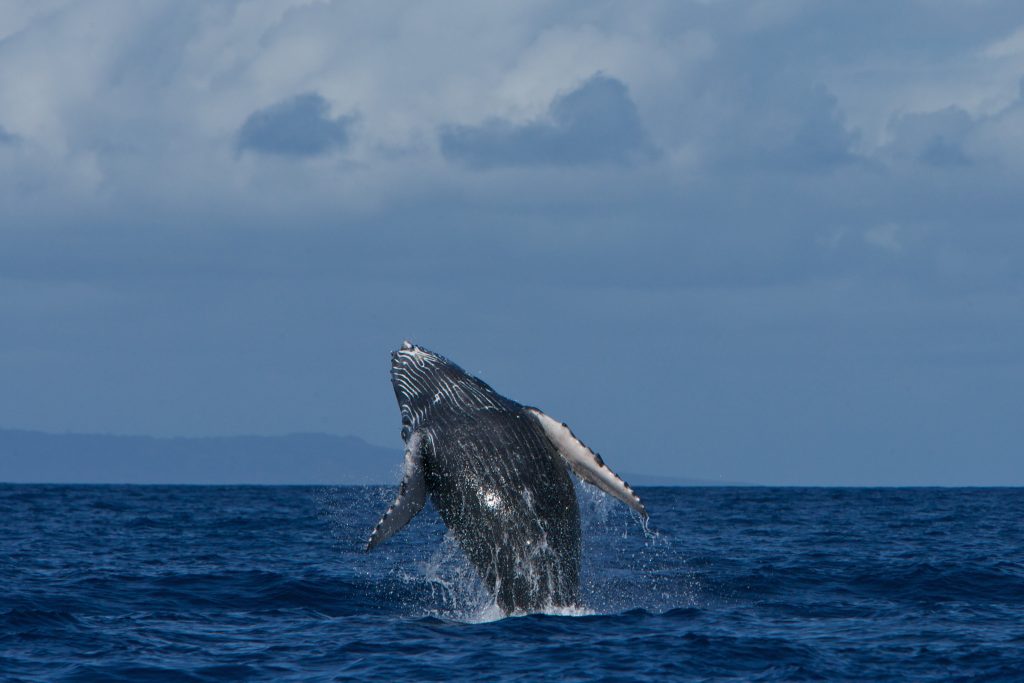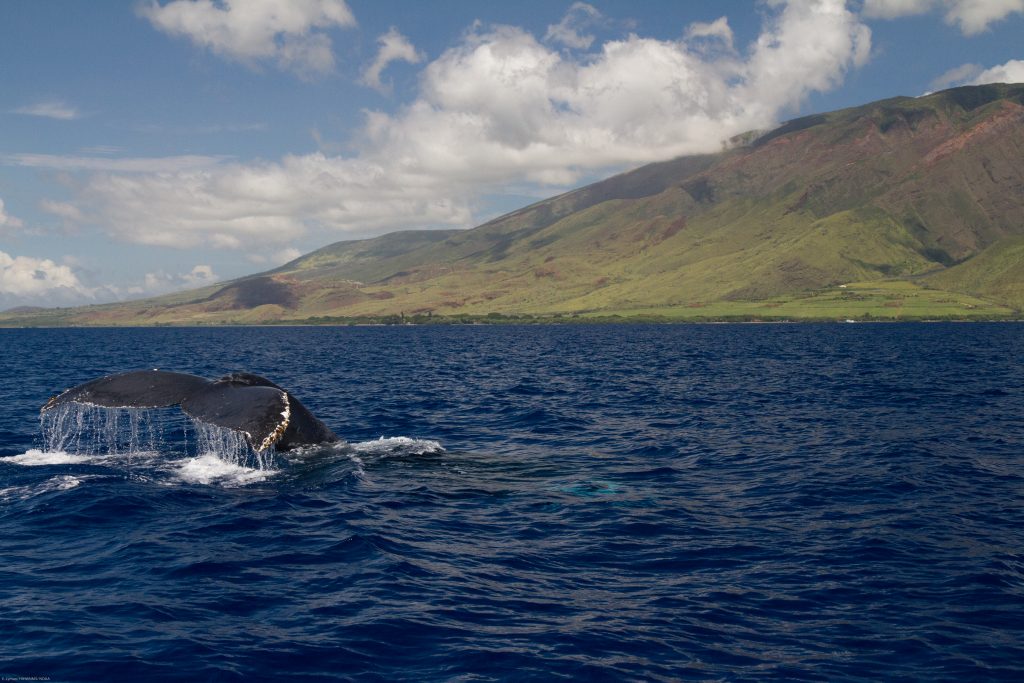Whale Week Trivia: Do all whales sing? Where is a whale’s hair? How fast are they?

“Whale Week” wrapped with “World Whale Day” on Sunday, Feb. 20
On Sunday, Feb. 20,2022, the Hawaiian Islands Humpback National Marine Sanctuary hosted a special outreach event at the Maui Ocean Center, in celebration of the annual event.
Here’s some whale trivia about the wintering whales that come to Hawaiʻi each year to breed, give birth, and nurse their young.
How far is the round trip and what is the average speed by which they travel?
Answer: The round trip is about 5,000 miles and they travel approximately 3-7 miles per hour. Humpback whales breed, calve and nurse in Hawai‘i in winter (November-May), then migrate to the Gulf of Alaska and other areas in the North Pacific to feed primarily in the summer (MayNovember)
A whale is a mammal: warm-blooded, able to breathe air, nurse their young and have hair. Where is the whale’s hair located?
Answer: Stiff hairs come out of the top of tubercles, large bumps on the head and lower jaw. It is thought that these hairs may serve a sensory function. Humpbacks also have tubercles without hair on the leading edge of the flippers that reduce drag and increase lift. The humpback whale is extremely maneuverable and the acrobat of the whale world.
Every whale has its claim to fame: The blue whale is known as the biggest whale (can be over 100 feet long and more than 110 tons). The sperm whale is known to be one of the deepest divers (depths of 10,500 feet have been recorded as it feeds on giant squid). The killer whale is one of the fastest swimmers. The humpback whale is known for its________.
Answer: The humpback is known for its songs. The complex series of sounds they make are called songs. Next time you are on or near the water, listen for a moment, maybe you’ll hear them!
Do all whales sing?
Answer: It’s the male whales who sing. The song is unique in that it consists of a series of repeating patterns that gradually change over time. Yet all the singers in a population sing the same version of the ever-changing song at any one time; the whales in the Pacific sing one song and the whales in the Atlantic another.
When was hunting for humpback whales banned?
Answer: The International Whaling Commission decided at its meeting in 1982 that there should be a pause (the ‘moratorium’) in commercial whaling on all whale stocks from 1985/86.
A group of cows is called a herd, a group of humpback whales is called a_______.
Answer: A group of humpback whales is called a group, and seems highly dependent on the sex of the whale. Female associations on the breeding grounds seem to be rare, but finding a mother/ calf pair is common. The proportion of these pairs with a male escort is consistently over 85 percent. Adult female whales may followed by groups of males (anywhere from two to over twenty).
About how long does a calf stay with its mother?
Answer: A calf spends about one year with its mother. Calves are born in the warm shallow waters around Hawai‘i, then travel with their mothers to the North Pacific summer feeding grounds. The following winter, some may accompany their mothers back to Hawai‘i. These calves, now called yearlings become independent in route or while on the feeding grounds.
The scientific name of the humpback whale is Megaptera noveangliae. What does the genus name (first word) mean?
Answer: “Megaptera” means “giant wings” which refers to their large front flippers, called pectoral or pec fins. These fins are about 1/3 the length of the body or about 15 feet long in an adult humpback whale.
Where does the name “humpback” whale come from?
Answer: They are named humpbacks because of the distinct “hump” that appears when the whale arches its back when it dives.
Who has the final say in choosing the right mate…the male or the female humpback whale?
Answer: Scientists believe it is the female who makes the final decision.
When does a whale become sexually mature?
Answer: Humpback whales become sexually mature between the ages of 4-8. A female gives birth every 2-3 three years and the pregnancy is 11-12 months. Hawai‘i’s humpback whales migrate from Alaska to Hawai‘i.
How long can a humpback whale hold its breath?
Answer: On average, adult humpbacks surface every 7-15 minutes to breathe but can remain submerged for up to 45 minutes. Calves must rise to the surface every 3-5 minutes. This behavior is easily spotted as the whale releases a “blow” that may be 10-20 feet tall. Whales typically exchange over 90% of the air in their lungs, making their lungs much more efficient than ours.
What is a “peduncle”?
Answer: The peduncle is the body part connecting the tail to the body. Humpback whales can be seen performing a variety of behaviors during the winter months in Hawai‘i, one of which is the “peduncle slap”, in which the whale throws its tail out of the water and in the process, slaps its peduncle on the surface.
What federal laws protect humpback whales?
Answer: The humpback whale is protected by the Marine Mammal Protection Act, making it illegal to harass, injure or kill a humpback whale in United States waters. The Endangered Species Act also protected the Northern Pacific humpback whale population until 2016, when this population was taken off the endangered species list.
How many blow holes does a humpback whale have?
Answer: A humpback whale has 2 blow holes on the top of its head. Toothed whales have only one blowhole. The warm moist lung air is mainly expelled from the blowholes as a cloud of condensation. It is this cloud of condensation that today helps us spot whales and in the whaling days, led to the famous…”Thar she blows”.
How have we learned about whales?
Answer: Our knowledge of whales has come in two distinct phases: studies of dead whales from the whaling industry, mostly ending in the 1960s; and studies of living whales at sea, which began in the 1970s. There is still much that is unknown about humpback whale biology. Any future biologists out there?
What is bubble net feeding?
Answer: Humpback whales work in a group to catch fish. In one type of feeding behavior, a whale swims in a large circle around a school of small fish, sending up a stream of bubbles to form a net of air around the fish. The other whales then lunge up through the middle of the bubble net with their mouths wide open to collect the fish. However, you won’t see this behavior in Hawaiian waters, because humpback whales do not eat while in Hawai‘i. They are here to breed, calve and nurse their young.
A baby dog is called a puppy. A baby whale is called a __.
Answer: A baby whale is called a calf. Calves are born in the warm shallow waters around Hawai‘i, and spend about one year with their mothers.
Do humpback whales eat while in Hawaiʻi?
Answer: No, humpbacks do not eat while in Hawaiʻi. Humpback whales breed, calve and nurse in Hawaiʻi in the winter (November-May), then migrate to the Gulf of Alaska and other areas in the North Pacific to feed in the summer (May-November), travelling over 2,500 miles each way.
More whale trivia can be found here.



















